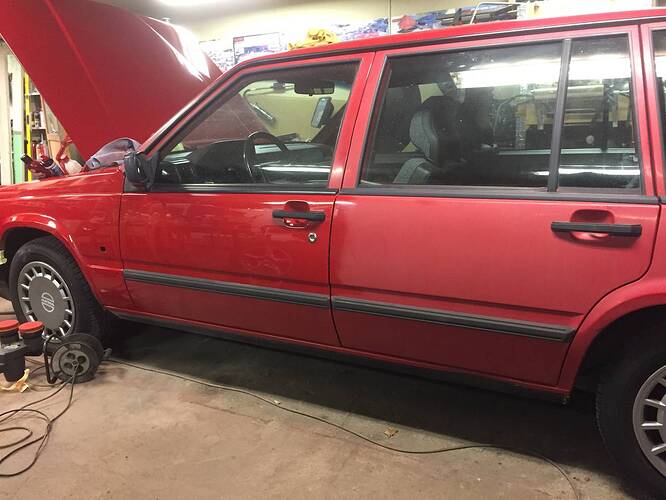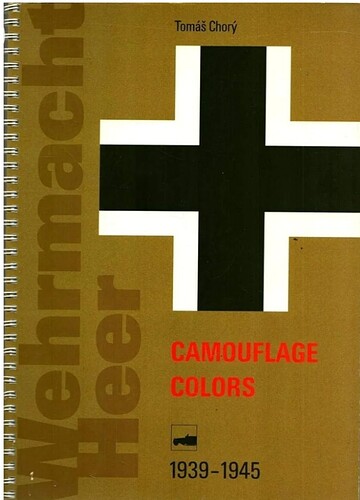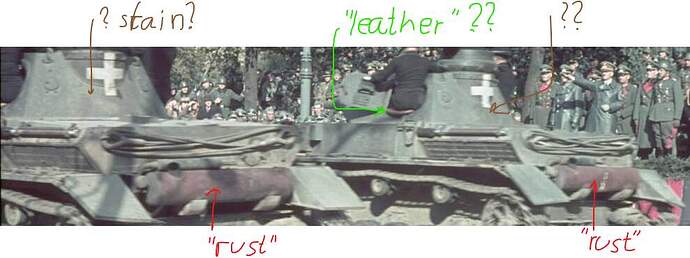That’s not opinion, that’s marketing. There is no required truth in marketing.
This may come as a shock, but not everything is about you.
While I included your quote (which did not include any qualifications, BTW) you are not the first or only person who has made such a remark.
KL
Ahhhh…I see! (Nudge, nudge…wink, wink). ![]()
![]()
![]()
Well…Excuuuuuse me!! ![]()
![]()
![]()
![]()
Thank you for a wonderful post. I mean it. You said it very well indeed.
I cannot stand the line of thought we often see that “anyone’s opinion is equally valid” on questions related to factual claims. If you want to pick your favorite tank, then yes, everyone’s opinion is equally valid. If you want to settle a factual claim, then no: some people really are far more knowledgeable than others.
Your comment should just be reported everywhere that folks are trying to sort through these sorts of questions.
The research as described is a great way to get to the paint as made. It was made to X standard, with Y amount of variation allowed, and applied in Z manner. But then the variables are introduced into the equation. Said vehicle left the factory, went to service area(s) and began the process of paint exposure to the elements. Dependent upon the service life of the vehicle, the paint will no longer have that factory new look, and due to local conditions will take on some degree of variation away from the original paint color standard. The longer the service life of the vehicle, the greater the potential for color change.
Volvo 740 from the 1980’ies, the rear door is the faded appearance, the front has been restored somehow
Rubbing compound.
Sometimes the owners could save the paintwork with rubbing compound and lots of work,
some other cars were too far gone so a re-paint was the only way out.
It was usually the hood and trunk lid.
The red pigment oxidized …
And sometimes factories just f up the paint and it’s still retains the original name. Happens w automobiles. In fact one of the lines the store I work at sells are fiberglass topper for trucks. Ram has such a poor reputation on color consistency that a few particular colors in a 16 month period back in the earlier 2000’s were so off that we actually have to remove the gas cap cover and send it in to be matched.
For the sake of ease (meaning I’m look up the spellings lol) we do know set standards related to say Panzer Grey or the Base Yellow. We also do know field applied browns and greens varied based on what was used to thin the paint. Likewise I do think a realistic argument can be made that the same occurred with greys and yellows as factories mid and late war certainly had to be resourceful also. No, I’m not saying paint your Tiger 1 dark gull grey FS 3……but I truly and with all sincerity doubt that panzer grey from week to week was to the paint chip matched with exact care. And I doubt if it was off that the tank was turned around back to the paint booth.
Just like German uniforms these undoubtedly a standard that veered dramatically. Therein lies our solution, enjoy a little artistic license if you care too in the end it is about fun and doing the best you can and striving for exacting accuracy if that’s your thing in either detailing or painting. But me, I’m never gonna paint chip compare some other guys build nor say anything unless it’s just blatantly apparent that it so far off the reservation that it can’t be ignored, explained or overlooked.
And now just for fun, from the same Poland victory parade, some of the tanks.
Even though cleaned up for the parade to some extent, the embedded dust and other weathering has markedly lightened the Dunkelgrau paint when compared to the wheeled vehicles photographed at the same time by the same photographer… same vantage point, lighting conditions, camera settings, and likely same roll of film.
One should probably take into consideration that German color film of the WW2 was Agfa. Agfa had a different chemistry that captured colors differently than other films. Sort of like how Ektachrome and Kodachrome are both color films but capture colors differently.
In other words one could build a model to perfectly match a WW2 German color photo but not actually have painted the model so that its color matched accurately to what the vehicle would have actually looked like in real life. In other words, due to film chemistry, German WW2 color photographs tend to mislead just as much as the propaganda represented.
There are a lot of excellent references available for those that are interested in German WW2 AFV colors. Typically the most accurate document digging back to the test sample cards German WW2 paint manufacturers had to match their paint against. There’s a fair amount of that sort of research. At least one surviving German WW2 paint manufacturer still whips up batches WW2 RAL spec paint for restoration projects. ![]()
![]()
![]() So the information isn’t lost just obscure.
So the information isn’t lost just obscure.
This book seems well researched and respected and makes a good starting point for a modeler’s research.
However, matching to an item in good condition known to be DunkelGrau RAL 7021 is also an excellent way to verify color accuracy.
13 Shades of Panzer Gray aka Dunkelgrau
13 hobby paints are matched to an original item by Bruce who has background in professionally matching colors and is familiar with the technology.
All the hobby paints failed except for Mr Paint MRP RAL 7021 Dunkelgrau which was a PERFECT match visually.
10 more Shades of Panzer Gray aka Dunkelgrau covers additional brands of hobby paint.
While this certainly is subject to revision and is only one data point etc, it appears Mr Paint MRP does their research correctly and provides an excellent match.
Cross checking against paint chips in books like Chory’s helps provide an additional layer of reassurance for those that are interested in such matters.
Personally, I like Floquil Military Panzer Gray - its definitely wrong verse Chory’s paint chips and wrong looking at the above video’s. However, it provides an excellent base to weather toward what looks reasonable and corrct based on period photos in dusty conditions, scale lighting of color due to size and distance.
I think having a reasonable ideal of what the original colors looked like helps the model achieve the desired goal regardless of what paint the modeler decides to use.
HTH & YMMV
Yeah baby we haven’t had a good all-in sht-fght over German camo for way too long. The Life photos have obviously degraded because we know exactly what colour the nazi flags were & they weren’t hot pink. So here’s an attempt at a red-bias adjustment, by no means ideal but at least the trees are more autumnal (this was presumably mid-October if celebrating Poland’s defeat) and the clouds are more grey than greeny-blue…
So what does that prove? Not much really, except are those brownish patches on the back of the turrets or just stains? ![]()
Wehrmacht Heer Camouflage Colors 1939 - 1945 was published 18 years ago and now long out of print. Is there a more recent book on the subject?
Doug,
I don’t follow the research as much these days after Jentz & Chory’s books were published.
Check this Missing Lynx thread - RAL
8020-7027 Paint Sample Card out.
There a lot of up to date info on the paint topic on Missing Lynx. I’m out of the loop on most of newer references.
Online this makes for an interesting read, PanzerWorld - German-Armor-Camouflage
There’s another book on Chory’s level that was due to be published but it was delayed a few years ago. I’ll see if I can find the title etc.
There’s a lot of books and information etc, Missing Lynx is a great filter to sift the wheat from the chaff. As always with this stuff, trust but verify and cross-reference if accurate information is critical.
HTH
I was able to score a Chory book a decade back, and with it’s individual paint chips, it is my bible for German WWII color reference. I match all of my paints against it. My club-mates will have to pry it out of my cold dead hands.
Also about a decade ago, Jentz and Doyle were on the verge of publishing a seminal original RAL paint chip book that would be an all encompassing tome, but Tom Jentz’s untimely death put an end to the project.
Now, the only book that comes close is AK Interactive’s “Real Colors of World War Two - Armor”. It is a very nice book, with several caveats. It includes many useful color photos of pristine original painted surfaces (inside of boxes, parts that were painted and then bolted together). It has printed color swatches, rather than paint chips (which are very expensive to produce). The colors are extensive, as are their line of Real Color paints. There are many color photos and color profiles throughout the book. Overall, it looks like a great reference. However, they open the book with a chapter on German primer which is just completely off-the-charts wrong. They list RAL 8012 Red Brown as German AFV primer, (wrong) and no where do they mention RAL 3009 Red Oxide, which was the paint used on all German AFV’s, except for Daimler, which used Grey Zinc Oxide. This is a huge stumble right out of the gate, so while a very nice book, I’m not sure I would use it as an empirical reference.
I was wondering about that myself. As these are color photos (and not colorised). why is the brown not evident? If this is, indeed, a Polish victory parade, then brown should still be in use. I was under the impression that brown over gray was a standard camo scheme for all AFV’s during this period. Did some units not have this?
![]()
![]()
- December 1, 1927 – Nr. 17 Erdgelb-matt, Nr. 28 Gruen-matt, Nr. 18 Braun-matt.
- November 7, 1938 – Nr. 46 Dunkelgrau covering 2/3, Nr. 45 Dunkelbraun covering 1/3.
- July 31, 1940 – Dunkelgrau RAL 7021.
- February 18, 1943 – Dunkelgelb RAL 7028 basecoat, Olivgrun RAL 6003, Rotbraun RAL 8017.
- August 19, 1944 – Dunkelgelb RAL 7028 basecoat, Olivgrun RAL 6003, Rotbraun RAL 8017 in Hinterhalt – Tarnung (the “Ambush” scheme).
- September 31, 1944 – Rotoxid primer, “sparingly applied patches” of Dunkelgelb RAL 7028, Olivgrun RAL 6003, Rotbraun RAL 8017.
- November 20, 1944 – Olivgrun RAL 6003 basecoat, Dunkelgelb RAL 7028, Rotbraun RAL 8017 “in sharp contours”. (To go into full effect June 1, 1945).
Tropen Pattern
- March 17, 1941 – Grunbraun RAL 8000 covering 2/3, Graugrun RAL 7008 covering 1/3.
- March 25, 1942 – Gelbbraun RAL 8020 covering 2/3, Sandgrau RAL 7027 covering 1/3.
Dates are Inspektorate 2 order dates.
RAL Farbtonkarte of June 1932 and RAL Farbtonkarte of February 10, 1941.
Note that RAL Farbtonkarte was revised in 1953 and 1961. Current RAL numbers, colors and titles DO NOT match World War II Numbers, colors and titles.
All units had the grey/brown camouflage, but the colors were so close together, you have to have a really clear, good color photograph to see the pattern. It’s almost imperceptible, which is why the Germans dropped the brown.
If that seat is brownish leather and the “rust” on the exhausts show up on the photos then I think that patches of brown camouflage would also be visible.
Ahhhh…I see. “Stealth Brown” - invisible colors! ![]()
![]()
![]()
Reminds me of a WWll-era Donald Duck cartoon where he’s ordered to paint some ordinance in “invisible paint”, and everyone keeps smacking into it! ![]()





